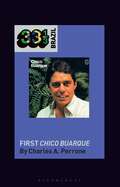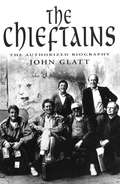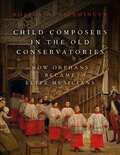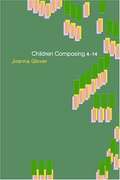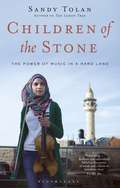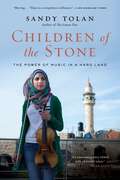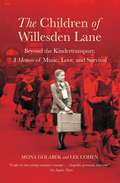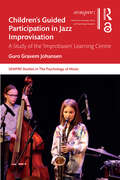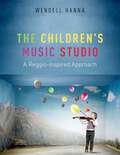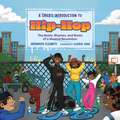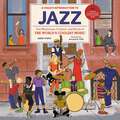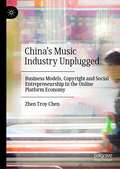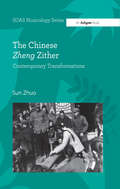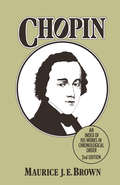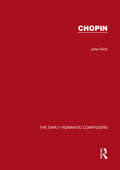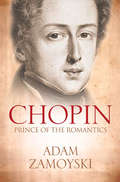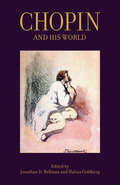- Table View
- List View
Chico Buarque's First Chico Buarque (33 1/3 Brazil)
by Charles A. PerroneChico Buarque comprises a critical appreciation of the self-titled album (1978), which is one of the Brazilian artist's most representative. This vibrant collection displays the singer-songwriter's singular talents as a composer/poet of songs with both popular appeal and keen analytical skills. The 11 tracks include both up-beat sambas and lyrical compositions: witty tunes, dramatic laments, international items, and, especially, epochal protest songs with fascinating histories. The album embodies Chico Buarque's affective sensibilities and sociopolitical engagement, and this book situates the album in inter-related contexts: the artist's own career; the evolution of the current he represents MPB (Brazilian Popular Music); and, especially, historical conjuncture-the period of military dictatorship in Brazil, 1964-85.
The Chieftains: The Authorised Biography
by John GlattThe Chieftains have become international superstars as well as being an institution in Folk Music. They have performed and recorded with such stars such as Bob Dylan, Van Morrison, The Rolling Stones, Mark Knopfler. . . . and others. This authorised biography will trace the history of the band and its members from its small beginnings in Ireland in the early 1960s to their current status, and will feature exclusive interviews with all the members of the band and many of their friends and collaborators, along with photographs and other memorabilia from the band's own collection.
Child Composers in the Old Conservatories: How Orphans Became Elite Musicians
by Robert O. GjerdingenIn seventeenth century Italy, overcrowding, violent political uprising, and plague led an astonishing number of abandoned and orphaned children to overwhelm the cities. Out of the piety of private citizens and the apathy of local governments, the system of conservatori was created to house, nurture, and train these fanciulli vaganti (roaming children) to become hatters, shoemakers, tailors, goldsmiths, cabinet makers, and musicians - a range of practical trades that might sustain them and enable them to contribute to society. Conservatori were founded across Italy, from Venice and Florence to Parma and Naples, many specializing in a particular trade. Four music conservatori in Naples gained particular renown for their exceptional training of musicians, both performers and composers, all boys. By the eighteenth century, the graduates of the Naples conservatories began to spread across Europe, with some 600 boys formerly in residence beginning to dominate the European musical world. Other conservatories in the country - including the Paris Conservatory - began to imitate the principles of the Naples' conservatory's training, known as the partimento tradition. The daily lessons and exercises associated with this tradition were largely lost-until author Robert Gjerdingen discovered evidence of them in the archives of conservatories across Italy and the rest of Europe. Compellingly narrated and richly illustrated, Child Composers in the Old Conservatory follows the story of these boys as they undergo rigorous training with the conservatory's maestri and eventually become maestri themselves, then moves forward in time to see the influence of partimenti in the training of such composers as Claude Debussy and Colette Boyer. Advocating for the revival of partimenti in modern music education, the book explores the tremendous potential of this tradition to enable natural musical fluency for students of all ages learning the craft today.
Child Composers in the Old Conservatories: How Orphans Became Elite Musicians
by Robert O. GjerdingenIn seventeenth century Italy, overcrowding, violent political uprising, and plague led an astonishing number of abandoned and orphaned children to overwhelm the cities. Out of the piety of private citizens and the apathy of local governments, the system of conservatori was created to house, nurture, and train these fanciulli vaganti (roaming children) to become hatters, shoemakers, tailors, goldsmiths, cabinet makers, and musicians - a range of practical trades that might sustain them and enable them to contribute to society. Conservatori were founded across Italy, from Venice and Florence to Parma and Naples, many specializing in a particular trade. Four music conservatori in Naples gained particular renown for their exceptional training of musicians, both performers and composers, all boys. By the eighteenth century, the graduates of the Naples conservatories began to spread across Europe, with some 600 boys formerly in residence beginning to dominate the European musical world. Other conservatories in the country - including the Paris Conservatory - began to imitate the principles of the Naples' conservatory's training, known as the partimento tradition. The daily lessons and exercises associated with this tradition were largely lost-until author Robert Gjerdingen discovered evidence of them in the archives of conservatories across Italy and the rest of Europe. Compellingly narrated and richly illustrated, Child Composers in the Old Conservatory follows the story of these boys as they undergo rigorous training with the conservatory's maestri and eventually become maestri themselves, then moves forward in time to see the influence of partimenti in the training of such composers as Claude Debussy and Colette Boyer. Advocating for the revival of partimenti in modern music education, the book explores the tremendous potential of this tradition to enable natural musical fluency for students of all ages learning the craft today.
Children Composing, 4-14 (PDF)
by Joanna GloverOFSTED have consistently identified composing as a less well taught aspect of the music curriculum. This book shows teachers how they can recognise and encourage music making in the classroom and so address all the needs of the National Curriculum for music. It is also based on research into best practice and makes clear suggestions for classroom practice for teachers of 4 to 14 years.
Children of the Stone: The Power of Music in a Hard Land
by Sandy TolanChildren of the Stone is the unlikely story of Ramzi Hussein Aburedwan, a boy from a Palestinian refugee camp in Ramallah who confronts the occupying army, gets an education, masters an instrument, dreams of something much bigger than himself, and then inspires scores of others to work with him to make that dream a reality.That dream is of a music school in the midst of a refugee camp in Ramallah, a school that will transform the lives of thousands of children through music. Daniel Barenboim, the Israeli musician and music director of La Scala in Milan and the Berlin Opera, is among those who help Ramzi realize his dream. He has played with Ramzi frequently, at chamber music concerts in Al-Kamandjati, the school Ramzi worked so hard to build, and in the West-Eastern Divan Orchestra that Barenboim founded with the late Palestinian intellectual, Edward Said.Children of the Stone is a story about music, freedom and conflict; determination and vision. It's a vivid portrait of life amid checkpoints and military occupation, a growing movement of nonviolent resistance, the past and future of musical collaboration across the Israeli-Palestinian divide, and the potential of music to help children see new possibilities for their lives. Above all, Children of the Stone chronicles the journey of Ramzi Aburedwan, and how he worked against the odds to create something lasting and beautiful in a war-torn land.
Children of the Stone: The Power of Music in a Hard Land
by Sandy TolanIt is an unlikely story. Ramzi Hussein Aburedwan, a child from a Palestinian refugee camp, confronts an occupying army, gets an education, masters an instrument, dreams of something much bigger than himself, and then, through his charisma and persistence, inspires others to work with him to make that dream real. The dream: a school to transform the lives of thousands of children--as Ramzi's life was transformed--through music. Musicians from all over the world came to help. A violist left the London Symphony Orchestra, in part to work with Ramzi at his new school. Daniel Barenboim, the eminent Israeli conductor, invited Ramzi to join his West Eastern Divan Orchestra, which he founded with the late Palestinian intellectual, Edward Said. Since then the two have played together frequently. Children of the Stone chronicles Ramzi's journey--from stone thrower to music student to school founder--and shows how through his love of music he created something lasting and beautiful in a land torn by violence and war. This is a story about the power of music, but also about freedom and conflict, determination and vision. It's a vivid portrait of life amid checkpoints and military occupation, a growing movement of nonviolent resistance, the prospects of musical collaboration across the Israeli-Palestinian divide, and the potential of music to help children everywhere see new possibilities for their lives.
The Children of Willesden Lane: Beyond the Kindertransport: A Memoir of Music, Love, and Survival
by Mona Golabek Lee CohenBased on the true story of her mother, Mona Golabek describes the inspirational story of Lisa Jura's escape from Nazi-controlled Austria to England on the famed Kindertransport. Jewish musical prodigy Lisa Jura has a wonderful life in Vienna. But when the Nazis start closing in on the city, life changes irreversibly. Although he has three daughters, Lisa's father is only able to secure one berth on the Kindertransport. The family decides to send Lisa to London so that she may pursue her dreams of a career as a concert pianist. Separated from her beloved family, Lisa bravely endures the trip and a disastrous posting outside London before finding her way to the Willesden Lane Orphanage. It is in this orphanage that Lisa's story truly comes to life. Her music inspires the other orphanage children, and they, in turn, cheer her on in her efforts to make good on her promise to her family to realize her musical potential. Through hard work and sheer pluck, Lisa wins a scholarship to study piano at the Royal Academy. As she supports herself and studies, she makes a new life for herself and dreams of reconnecting with the family she was forced to leave behind. The resulting tale delivers a message of the power of music to uplift the human spirit and to grant the individual soul endurance, patience, and peace.
Children’s Guided Participation in Jazz Improvisation: A Study of the ‘Improbasen’ Learning Centre (SEMPRE Studies in The Psychology of Music)
by Guro Gravem JohansenImprobasen is a Norwegian private learning centre that offers beginner's instrumental tuition within jazz improvisation for children between the ages of 7 and 15. This book springs out of a two-year ethnographic study of the teaching and learning activity at Improbasen, highlighting features from the micro-interactions within the lessons, the organisation of Improbasen, and its international activity. Music teachers, students, and scholars within music education as well as jazz research will benefit from the perspectives presented in the book, which shows how children systematically acquire tools for improvisation and shared codes for interplay. Through a process of guided participation in jazz culture, even very young children are empowered to take part in a global, creative musical practice with improvisation as an educational core. This book critically engages in current discussions about jazz pedagogy, inclusion and gender equity, beginning instrumental tuition, creativity, and authenticity in childhood.
Children’s Guided Participation in Jazz Improvisation: A Study of the ‘Improbasen’ Learning Centre (SEMPRE Studies in The Psychology of Music)
by Guro Gravem JohansenImprobasen is a Norwegian private learning centre that offers beginner's instrumental tuition within jazz improvisation for children between the ages of 7 and 15. This book springs out of a two-year ethnographic study of the teaching and learning activity at Improbasen, highlighting features from the micro-interactions within the lessons, the organisation of Improbasen, and its international activity. Music teachers, students, and scholars within music education as well as jazz research will benefit from the perspectives presented in the book, which shows how children systematically acquire tools for improvisation and shared codes for interplay. Through a process of guided participation in jazz culture, even very young children are empowered to take part in a global, creative musical practice with improvisation as an educational core. This book critically engages in current discussions about jazz pedagogy, inclusion and gender equity, beginning instrumental tuition, creativity, and authenticity in childhood.
The Children's Music Studio: A Reggio-inspired Approach
by Wendell HannaThe Children's Music Studio provides music teachers, parents and early childhood educators a wealth of materials and a clear roadmap for applying Reggio Emilia principles and practices to preschool and early childhood music education. Drawing on Professor Hanna's extensive experience researching and teaching in Reggio-inspired music classrooms, this pioneering book provides a comprehensive and in-depth manual for designing music ateliers-hands-on studios that capture the imagination and creativity of children. Informed by the cutting edge research on music learning, this practical guide includes detailed studio plans, examples of Reggio-inspired music studio explorations and documentation of children's work in music studios. In this book you will: - Discover how children can naturally learn music through the studio approach - See detailed examples and documentation of project-based studio learning - Understand how music learning increases overall artistic and academic literacy across the curriculum - Learn how to develop customized projects for your classroom that will teach children to think and communicate fluently through music and sound Early childhood and elementary music teachers will find this book especially useful as it provides innovative ideas for Reggio-inspired music teaching and learning techniques that can be integrated into the existing curriculum.
The Children's Music Studio: A Reggio-inspired Approach
by Wendell HannaThe Children's Music Studio provides music teachers, parents and early childhood educators a wealth of materials and a clear roadmap for applying Reggio Emilia principles and practices to preschool and early childhood music education. Drawing on Professor Hanna's extensive experience researching and teaching in Reggio-inspired music classrooms, this pioneering book provides a comprehensive and in-depth manual for designing music ateliers-hands-on studios that capture the imagination and creativity of children. Informed by the cutting edge research on music learning, this practical guide includes detailed studio plans, examples of Reggio-inspired music studio explorations and documentation of children's work in music studios. In this book you will: - Discover how children can naturally learn music through the studio approach - See detailed examples and documentation of project-based studio learning - Understand how music learning increases overall artistic and academic literacy across the curriculum - Learn how to develop customized projects for your classroom that will teach children to think and communicate fluently through music and sound Early childhood and elementary music teachers will find this book especially useful as it provides innovative ideas for Reggio-inspired music teaching and learning techniques that can be integrated into the existing curriculum.
A Child's Introduction to Hip-Hop: The Beats, Rhymes, and Roots of a Musical Revolution (A Child's Introduction Series)
by Jordannah ElizabethThis definitive guide to hip-hop teaches kids about the history and world-wide cultural impact of the genre, covering everyone from early heroes like The Sugar Hill Gang, Kurtis Blow, and Run D.M.C., to modern day titans like Kanye West, Cardi B, and Kendrick Lamar. In the 1970s, a musical and cultural movement was sparked in the Bronx neighborhood of New York City. Led by three DJs who performed at local block parties, DJ Kool Herc, Afrika Bambaataa, and Grandmaster Flash become known as the &“Holy Trinity&” of hip-hop and they helped establish the four main pillars of the genre: deejaying, mc'ing, break dancing, and graffiti art. From these early days, acclaimed journalist and music critic Jordannah Elizabeth takes kids on a journey through the history of hip-hop, helping young readers understand how and why it was invented, and how it evolved into a powerful platform that gave (and still gives) a voice to the often-ignored Black community in America. From Tupac Shakur and Ms. Lauryn Hill to Drake and Tyler the Creator, kids will celebrate some of hip-hop&’s biggest names while learning about the roots of their musical sounds, and the community that propelled them into stardom. Packed with modern, charming illustrations, including a pull-out poster for kids to color, A Child&’s Introduction to Hip-Hop features age-appropriate descriptions of a musical genre that is changing the world and dominating the airwaves. This is the perfect book for young students who want to know more about the world of hip-hop and rap, as well as for parents who want to introduce their children to some of their favorite artists.
A Child's Introduction to Jazz: The Musicians, Culture, and Roots of the World's Coolest Music (A Child's Introduction Series)
by Jabari AsimGet ready to swing with A Child&’s Introduction to Jazz, an interactive journey into one of the richest and most soulful music genres in the world. Listen while you learn with QR codes that will connect you to the instruments and musical flair of jazz. Welcome to jazz! Feel the music and rhythms of all the different styles of jazz, from swing and Dixieland to the blues and bebop, with this interactive introduction to the world&’s coolest music.Author Jabari Asim will take you on the journey through the history of jazz as you discover the most important musicians and singers while hearing some really cool sounds. You&’ll learn all about the roots of jazz in Africa and New Orleans and how the music traveled to different parts of the United States and around the world. Along the way you&’ll meet legendary trumpeter Louis Armstrong, who shaped a new form of jazz called improvisation; pianist and bandleader Duke Ellington, who helped create the big band sound of the swing era; and the singer Billie Holiday, whose songs such as &“God Bless the Child,&” &“Don&’t Explain,&” and &“Lady Sings the Blues&” have become jazz standards.Listen along to the sounds of jazz by downloading music and hearing instruments such as trumpets, clarinets, trombones, and even singers scatting as they improvise melodies. With a pull-out poster showing the different instruments of jazz, A Child&’s Introduction to Jazz hits the perfect beat and will have you bebopping and scatting in no time!
China and the West: Music, Representation, and Reception
by Michael Saffle Hon-Lun YangWestern music reached China nearly four centuries ago, with the arrival of Christian missionaries, yet only within the last century has Chinese music absorbed its influence. As China and the West demonstrates, the emergence of “Westernized” music from China—concurrent with the technological advances that have made global culture widely accessible—has not established a prominent presence in the West. China and the West brings together essays on centuries of Sino-Western musical exchange by musicologists, ethnomusicologists, and music theorists from around the world. It opens with a look at theoretical approaches of prior studies of musical encounters and a comprehensive survey of the intercultural and cross-cultural theoretical frameworks—exoticism, orientalism, globalization, transculturation, and hybridization—that inform these essays. Part I focuses on the actual encounters between Chinese and European musicians, their instruments and institutions, and the compositions inspired by these encounters, while Part II examines theatricalized and mediated East-West cultural exchanges, which often drew on stereotypical tropes, resulting in performances more inventive than accurate. Part III looks at the musical language, sonority, and subject matters of “intercultural” compositions by Eastern and Western composers. Essays in Part IV address reception studies and consider the ways in which differences are articulated in musical discourse by actors serving different purposes, whether self-promotion, commercial marketing, or modes of nationalistic—even propagandistic—expression. The volume’s extensive bibliography of secondary sources will be invaluable to scholars of music, contemporary Chinese culture, and the globalization of culture.
China’s Music Industry Unplugged: Business Models, Copyright and Social Entrepreneurship in the Online Platform Economy
by Zhen Troy ChenThis research book is the first of its kind to conduct an interdisciplinary research on the recent and dramatic developments in China’s music industries with a particular focus on business models, copyright protection, and artist compensation. The monograph explores and discusses proper business models through which revenue can be generated and maintained in a changing copyright climate and transforming business environment. It also discusses how musicians can be fairly compensated in the online platform economy informed by social entrepreneurship. This book is distinctive in the sense that it explores the intersection of cultural and creative industries, legal studies, business studies, and new media. It uses a qualitative and mixed-method approach to study business innovations and institutions in the making in the second largest economy which is also gaining cultural and political significance around the world.
The Chinese Zheng Zither: Contemporary Transformations (SOAS Studies in Music Series)
by Sun ZhuoThe zheng zither is one of the most popular instruments in contemporary China. It is commonly regarded as a solo instrument with a continuous tradition dating back to ancient times. But in fact, much of its contemporary solo repertory is derived from several different regional folk ensemble repertories of the mid-twentieth century. Since the setting up of China’s modern conservatories, the zheng has been transformed within these new contexts of professional music-making. Over the course of the twentieth century, these regional folk repertories were brought into the performance traditions of modern regional zheng schools. From this basis, a large new zheng repertory was created by conservatory musicians, combining aspects of Western classical music with folk music materials. With the ’opening up’ of China’s economy since the 1980s, the zheng has been brought into the wider stage of international music-making which includes contemporary art music compositions by overseas based Chinese composers and commercial world music works by Western composers. Through a series of case studies, this book explores how the transformation of the Chinese zheng has constantly responded to its changing social context, critiquing the long-standing arguments concerning ’authenticity’ in the development of tradition. This work arises out of, and reflects on, the research methodologies known as performance as research. As an insider to the tradition, brought up within China’s zheng society, a trained and practising zheng performer, this study is largely drawn from the author's own experiences of practising and performing the music in question; her study also draws on fieldwork, as well as primary and secondary written sources in Chinese and English. This book is accompanied by a DVD which contains audio visual materials relating to the author's fieldwork and zheng performances by different zheng musicians.
The Chinese Zheng Zither: Contemporary Transformations (SOAS Studies in Music Series)
by Sun ZhuoThe zheng zither is one of the most popular instruments in contemporary China. It is commonly regarded as a solo instrument with a continuous tradition dating back to ancient times. But in fact, much of its contemporary solo repertory is derived from several different regional folk ensemble repertories of the mid-twentieth century. Since the setting up of China’s modern conservatories, the zheng has been transformed within these new contexts of professional music-making. Over the course of the twentieth century, these regional folk repertories were brought into the performance traditions of modern regional zheng schools. From this basis, a large new zheng repertory was created by conservatory musicians, combining aspects of Western classical music with folk music materials. With the ’opening up’ of China’s economy since the 1980s, the zheng has been brought into the wider stage of international music-making which includes contemporary art music compositions by overseas based Chinese composers and commercial world music works by Western composers. Through a series of case studies, this book explores how the transformation of the Chinese zheng has constantly responded to its changing social context, critiquing the long-standing arguments concerning ’authenticity’ in the development of tradition. This work arises out of, and reflects on, the research methodologies known as performance as research. As an insider to the tradition, brought up within China’s zheng society, a trained and practising zheng performer, this study is largely drawn from the author's own experiences of practising and performing the music in question; her study also draws on fieldwork, as well as primary and secondary written sources in Chinese and English. This book is accompanied by a DVD which contains audio visual materials relating to the author's fieldwork and zheng performances by different zheng musicians.
Chopin
by John RinkThis anthology brings together representative examples of the most significant and engaging scholarly writing on Chopin by a wide range of authors. The essays selected for the volume portray a rounded picture of Chopin as composer, pianist and teacher of his music, and of his overall achievement and legacy. Historical perspectives are offered on Chopin’s biography ’as cultural discourse’, on the evolution and origins of his style, and on the contexts of given works. A fascinating contemporary overview of Chopin’s oeuvre is also provided. Seven source studies assess the status and role of Chopin’s notational practices as well as some enigmatic sketch material. Essays in the field of performance studies scrutinise the ’cultural work’ carried out by Chopin’s performances and discuss his playing style along with that of his contemporaries and students. This paves the way for a body of essays on analysis, aesthetics and reception, considering aspects of genre and including an overview of analytical approaches to select works. The remaining essays address Chopin’s handling of form, rhythm and other musical elements, as well as the ’meaning’ of his msuic. The collection as a whole underscores one of the most important aspects of Chopin’s legacy, namely the paradoxical manner in which he drew from the past - in particular, certain eighteenth-century traditions - while stretching inherited conventions and practices to such an extent that a highly original ’music of the future’ was heralded.
Chopin
by John RinkThis anthology brings together representative examples of the most significant and engaging scholarly writing on Chopin by a wide range of authors. The essays selected for the volume portray a rounded picture of Chopin as composer, pianist and teacher of his music, and of his overall achievement and legacy. Historical perspectives are offered on Chopin’s biography ’as cultural discourse’, on the evolution and origins of his style, and on the contexts of given works. A fascinating contemporary overview of Chopin’s oeuvre is also provided. Seven source studies assess the status and role of Chopin’s notational practices as well as some enigmatic sketch material. Essays in the field of performance studies scrutinise the ’cultural work’ carried out by Chopin’s performances and discuss his playing style along with that of his contemporaries and students. This paves the way for a body of essays on analysis, aesthetics and reception, considering aspects of genre and including an overview of analytical approaches to select works. The remaining essays address Chopin’s handling of form, rhythm and other musical elements, as well as the ’meaning’ of his msuic. The collection as a whole underscores one of the most important aspects of Chopin’s legacy, namely the paradoxical manner in which he drew from the past - in particular, certain eighteenth-century traditions - while stretching inherited conventions and practices to such an extent that a highly original ’music of the future’ was heralded.
Chopin: The Great Composers (The Great Composers)
by Michael SteenWelcome to The Independent’s new ebook series The Great Composers, covering fourteen of the giants of Western classical music. Extracted from Michael Steen’s book The Lives and Times of the Great Composers, these concise guides, selected by The Independent’s editorial team, explore the lives of composers as diverse as Mozart and Puccini, reaching from Bach to Brahms, set against the social, historical and political forces which affected them, to give a rounded portrait of what it was like to be alive and working as a musician at that time. ‘After playing Chopin, I feel as if I had been weeping over sins that I had never committed, and mourning over tragedies that were not my own.’ In his typically perverse way, Oscar Wilde puts his finger on the fact that no one can capture a mood quite like Chopin. Where Liszt dazzles with technical virtuosity, Chopin's music concentrates on nuance and expressive depth. His ballades, nocturnes, preludes and etudes, and even those pieces based on dance forms, the waltzes, polkas and mazurkas, belong essentially to the salon (it is reckoned Chopin gave no more than 30 public concerts in his life). Yet his predominantly solo piano works, full of harmonic invention and poetic power, are universally acknowledged as a pinnacle of the repertoire. Frederic Chopin, though born in Poland, spent most of his adult life in France. Michael Steen follows his tragically short life from the early years in Warsaw and Vienna, to the Paris of the 1830s, the Paris of Rossini, Berlioz, Liszt and George Sand. Chopin's notorious affair with Sand, the outrageous free-thinking, trouser-wearing, smoking, female author, was a central feature of his life, but it ended bitterly. Strangled with tuberculosis, exhausted with coughing, he undertook a short visit to England and Scotland. Soon after returning to France, he finally yielded to the disease which had been gnawing away at him for so long.
Chopin
by Adam ZamoyskiA completely new edition of the definitive biography of Chopin, unavailable for many years, by one of the finest of contemporary European historians.
Chopin and His World
by Jonathan D. Bellman Halina GoldbergA new look at the life, times, and music of Polish composer and piano virtuoso Fryderyk ChopinFryderyk Chopin (1810–49), although the most beloved of piano composers, remains a contradictory figure, an artist of virtually universal appeal who preferred the company of only a few sympathetic friends and listeners. Chopin and His World reexamines Chopin and his music in light of the cultural narratives formed during his lifetime. These include the romanticism of the ailing spirit, tragically singing its death-song as life ebbs; the Polish expatriate, helpless witness to the martyrdom of his beloved homeland, exiled among friendly but uncomprehending strangers; the sorcerer-bard of dream, memory, and Gothic terror; and the pianist's pianist, shunning the appreciative crowds yet composing and improvising idealized operas, scenes, dances, and narratives in the shadow of virtuoso-idol Franz Liszt. The international Chopin scholars gathered here demonstrate the ways in which Chopin responded to and was understood to exemplify these narratives, as an artist of his own time and one who transcended it. This collection also offers recently rediscovered artistic representations of his hands (with analysis), and—for the first time in English—an extended tribute to Chopin published in Poland upon his death and contemporary Polish writings contextualizing Chopin's compositional strategies. The contributors are Jonathan D. Bellman, Leon Botstein, Jean-Jacques Eigeldinger, Halina Goldberg, Jeffrey Kallberg, David Kasunic, Anatole Leikin, Eric McKee, James Parakilas, John Rink, and Sandra P. Rosenblum. Contemporary documents by Karol Kurpiński, Adam Mickiewicz, and Józef Sikorski are included.
Chopin and His World (PDF)
by Jonathan D. Bellman Halina GoldbergA new look at the life, times, and music of Polish composer and piano virtuoso Fryderyk ChopinFryderyk Chopin (1810–49), although the most beloved of piano composers, remains a contradictory figure, an artist of virtually universal appeal who preferred the company of only a few sympathetic friends and listeners. Chopin and His World reexamines Chopin and his music in light of the cultural narratives formed during his lifetime. These include the romanticism of the ailing spirit, tragically singing its death-song as life ebbs; the Polish expatriate, helpless witness to the martyrdom of his beloved homeland, exiled among friendly but uncomprehending strangers; the sorcerer-bard of dream, memory, and Gothic terror; and the pianist's pianist, shunning the appreciative crowds yet composing and improvising idealized operas, scenes, dances, and narratives in the shadow of virtuoso-idol Franz Liszt. The international Chopin scholars gathered here demonstrate the ways in which Chopin responded to and was understood to exemplify these narratives, as an artist of his own time and one who transcended it. This collection also offers recently rediscovered artistic representations of his hands (with analysis), and—for the first time in English—an extended tribute to Chopin published in Poland upon his death and contemporary Polish writings contextualizing Chopin's compositional strategies. The contributors are Jonathan D. Bellman, Leon Botstein, Jean-Jacques Eigeldinger, Halina Goldberg, Jeffrey Kallberg, David Kasunic, Anatole Leikin, Eric McKee, James Parakilas, John Rink, and Sandra P. Rosenblum. Contemporary documents by Karol Kurpiński, Adam Mickiewicz, and Józef Sikorski are included.
